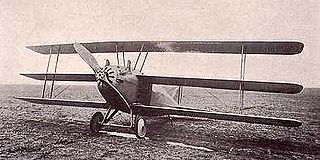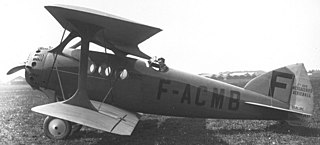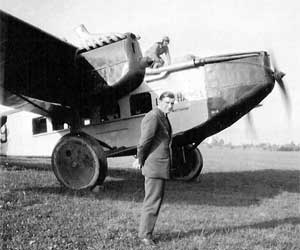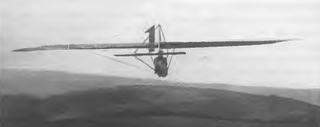Related Research Articles

The Piper PA-24 Comanche is an American four-seat or six-seat, low-wing, all-metal, light aircraft of semi-monocoque construction with tricycle retractable landing gear. Piper Aircraft designed and developed the Comanche, which first flew on May 24, 1956. Together with the PA-30 and PA-39 Twin Comanche, it made up the core of the Piper Aircraft lineup until 1972, when the production lines for both aircraft were wiped out in a flood.

The Sukhoi Su-9 was a single-engine, all-weather, missile-armed interceptor aircraft developed by the Soviet Union.

The Vultee XP-54 Swoose Goose was a prototype fighter built by the Vultee Aircraft Company for the United States Army Air Forces (USAAF).

VL Pyry was a Finnish low-winged, two-seated fighter trainer aircraft, built by the State Aircraft Factory for use with the Finnish Air Force. The Pyry was in use from 1939 to 1962. The aircraft was a mixed construction of wood, steel, fabric, and duraluminium.

The Bristol Type 138 High Altitude Monoplane was a British high-altitude research aircraft developed and produced by the Bristol Aeroplane Company during the 1930s. It holds the distinction of setting nine separate altitude world records, the ultimate of these occurring on 30 June 1937, during a 2¼-hour flight flown by Flight Lieutenant M.J. Adam, in which he achieved a record altitude, which was later homologated by the Fédération Aéronautique Internationale as having attained a maximum altitude of 53,937 ft (16,440 m).

The Avro 534 Baby was a British single-seat light sporting biplane built shortly after the First World War.

The Curtiss 18T, unofficially known as the Wasp and by the United States Navy as the Kirkham, was an early American triplane fighter aircraft designed by Curtiss for the US Navy.

The Blériot 155 was a French airliner of the 1920s. It was a four-engined biplane developed from the Blériot 115 and 135, but larger than these aircraft. Two were built for use by Air Union on their Paris-London route. Both were lost in accidents in 1926.

The Bleriot-SPAD S.33 was a small French airliner developed soon after World War I. The aircraft was a biplane of conventional configuration whose design owed much to the Blériot company's contemporary fighter designs such as the S.20. Four passengers could be accommodated in an enclosed cabin within the monocoque fuselage, and a fifth passenger could ride in the open cockpit beside the pilot. A great success, the S.33 dominated its field throughout the 1920s, initially on CMA's Paris-London route, and later on continental routes serviced by Franco-Roumaine.

The Fokker F.25 Promotor, first flown in 1946, was a single-engined, twin-boomed, four-passenger monoplane with a pusher engine mounted at the rear of a central nacelle. It was of wooden construction and has fitted with a retractable nosewheel undercarriage. One feature of the design was that instead of a 2 + 2 seating, the pilot sat in front to the left, and all three passengers were on a bench seat to the rear of him. Alternatively, when being used as an air ambulance aircraft, it could carry a patient on a stretcher, which was loaded through a hatch in the aircraft's nose. The F.25 was evocative of the pre-war G.I design. The F.25 was based upon the design of the Difoga 421 aircraft, home-built and -designed during World War II by Frits Diepen, a Ford garage owner from Tilburg, the Netherlands. His intention was to create an easy to fly personal aircraft. Due to the war an aircraft engine was not available and instead it used a Ford V-8.

The Caudron C.109 was a light utility aircraft built in France in the late 1920s.

The Curtiss CS was a reconnaissance and torpedo bomber aircraft used by the United States Navy during the 1920s. It was a large single-engine biplane with single-bay unstaggered wings, the design conventional in all respects other than that the lower wing was of greater span than the upper. The CS was built to allow its undercarriage to be quickly and easily interchangeable between wheeled, tailskid undercarriage, and twin pontoons for operation from water. Provision for the carriage of a torpedo was semi-recessed into the underside of the fuselage, blended in behind an aerodynamic fairing. The pilot and gunner sat in tandem open cockpits, while accommodation inside the fuselage was provided for a third crewmember who served as bombardier and radio operator. This station was also provided with a dorsal hatch aft of the gunner's position, and a ventral blister aft of the torpedo recess, which was used for aiming bombs or torpedoes.

The Grob G 520 is a turboprop long-endurance, high-altitude reconnaissance and surveillance aircraft built by Grob Aircraft with short runway capabilities and full approval for all-weather IFR/icing operations according to LBA/FAA Part 23 regulations. Developed and certified in 1991, the Grob G 520 is one of the world's largest fully composite manned aircraft and holder of several world records. Production was resumed in 2014.

The Fokker F.IV was an airliner designed in the Netherlands in the early 1920s, with only two ever made, both for the United States Army Air Service.

The Sikorsky S-10 was a Russian military twin-float seaplane that served with the Russian Navy's Baltic Fleet from the summer of 1913 to 1915. After Igor Sikorsky built the successful Sikorsky S-6 for the Russian military, he tried to build another successful aircraft for them. The S-10 was a modified S-6B built by the Russo-Baltic Carriage Factory. Approximately sixteen production versions of the S-10 were built. It had a less powerful engine and generally weaker structure than the S-6. They had either an 80 hp Gnome Monosoupape or a 100 hp Argus Motoren engine. Some were deployed on the world's first operational seaplane carriers.

The Rohrbach Ro VIII Roland was an airliner produced in Germany during the 1920s. It was a conventional strut-braced, high-wing monoplane, based loosely on the Zeppelin-Staaken E-4/20 that Adolf Rohrbach designed in 1920. It had a fully enclosed flight deck and passenger cabin, and featured fixed, tailskid undercarriage. Power was supplied by three engines, one in the nose, and two mounted in nacelles on the wings. Construction was of metal throughout.

The Ago Ao 192 Kurier was a small German twin-engined aircraft designed and built by AGO Flugzeugwerke in the 1930s. A small production run of six aircraft followed three prototypes, these being used as transports.

The Sb.1 Münchener Eindecker, Loessl Sb.1 Münchener Eindecker,, was a high-wing single-seat glider with an unusual method of pitch and roll control. It won prizes at the second Rhön competition held on the Wasserkuppe in 1921.

The D.W.L. SG-21 Lwów was a Polish high performance sailplane built for the Polish government. Though both it and a development, the SG-28, were one-offs, they set several national records and led to the batch-produced Warsztaty Szybowcowe SG-3.
The Kawanishi K6K was a prototype Japanese training aircraft built by the Kawanishi Aircraft Company in the late 1930s.
References
- Taylor, Michael J. H. (1989). Jane's Encyclopedia of Aviation. London: Studio Editions. p. 239.
- Planeurs et Avions